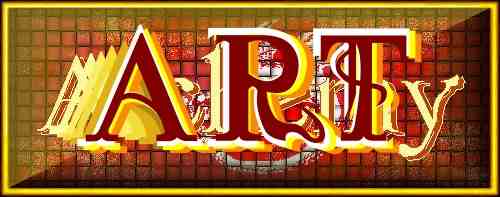

| The Essential Element ~ SHAPE |
![]() Shape exists by the joining of one or more lines (actual or implied) at their ends (or, in the case of a single line such as a curved line, at both its ends). Shape is dependent on the element of line in order to exist. This fact is inherent to shape’s nature.
Shape exists by the joining of one or more lines (actual or implied) at their ends (or, in the case of a single line such as a curved line, at both its ends). Shape is dependent on the element of line in order to exist. This fact is inherent to shape’s nature.
![]() As with line there are various configurations of shapes, to which certain universal properties can be applied. And as with the case of line, shape may incorporate certain aspects of the various other basic elements.
As with line there are various configurations of shapes, to which certain universal properties can be applied. And as with the case of line, shape may incorporate certain aspects of the various other basic elements.
![]() Differences in configurations are defined by the number of lines employed in the structural formation of the shape. One line, joined at its ends, represents the most basic of shapes: the circle. Such a shape ( as is the case with all shapes) exists only in the event that the line’s end points do in fact meet, forming an unbroken sequence; otherwise it would exist as merely a curved line. Two lines, at least one of which of necessity must exist as a curved line, joined at their ends would form an ellipse. Three lines joined together at their ends form a triangle. Four lines form a rectangle. Five lines, a pentagon. Six lines, a hexagon. Seven, a heptagon. Eight, an octagon. Nine, a nonagon. Ten lines form a decagon. The list of possible shape configurations proceeds to infinity, all being dependent and characterized by the number of lines which are joined together forming the-sides of the shape itself.
Differences in configurations are defined by the number of lines employed in the structural formation of the shape. One line, joined at its ends, represents the most basic of shapes: the circle. Such a shape ( as is the case with all shapes) exists only in the event that the line’s end points do in fact meet, forming an unbroken sequence; otherwise it would exist as merely a curved line. Two lines, at least one of which of necessity must exist as a curved line, joined at their ends would form an ellipse. Three lines joined together at their ends form a triangle. Four lines form a rectangle. Five lines, a pentagon. Six lines, a hexagon. Seven, a heptagon. Eight, an octagon. Nine, a nonagon. Ten lines form a decagon. The list of possible shape configurations proceeds to infinity, all being dependent and characterized by the number of lines which are joined together forming the-sides of the shape itself.
![]() The first four examples would include the following:
The first four examples would include the following:
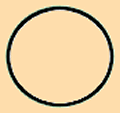 A single line, joined at its two ends, creates a single sided shape, commonly called a circle.
A single line, joined at its two ends, creates a single sided shape, commonly called a circle.
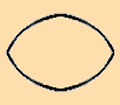 Two lines, joined at their ends, create a two sided shape, commonly called an ellipse.
Two lines, joined at their ends, create a two sided shape, commonly called an ellipse.
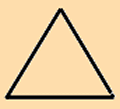 Three lines, joined at their ends, create a three sided shape, commonly called a triangle.
Three lines, joined at their ends, create a three sided shape, commonly called a triangle.
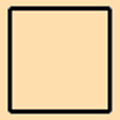 Four lines, joined at their ends, create a four sided shape, commonly called a square.
Four lines, joined at their ends, create a four sided shape, commonly called a square.
![]() The properties which apply to line itself also apply to shape, with one notable addition. Almost all shapes exist with some sort of orientation or direction. Excepting the circle, all shapes may be oriented in a general direction such as horizontal, vertical or diagonal. This aspect is not so clearly defined as with the case of line, but in most cases there does exist a predominant direction or orientation to shape.
The properties which apply to line itself also apply to shape, with one notable addition. Almost all shapes exist with some sort of orientation or direction. Excepting the circle, all shapes may be oriented in a general direction such as horizontal, vertical or diagonal. This aspect is not so clearly defined as with the case of line, but in most cases there does exist a predominant direction or orientation to shape.
![]() The property of length, so important to line, likewise affects the nature of shape. Length influences shape in either of two ways.
The property of length, so important to line, likewise affects the nature of shape. Length influences shape in either of two ways.
![]() The primary influence of length is on the overall size of the shape as a whole, relative to the surface on which it exists and to the other elements in its company. A shape may be defined by size as small, medium or large.
The primary influence of length is on the overall size of the shape as a whole, relative to the surface on which it exists and to the other elements in its company. A shape may be defined by size as small, medium or large.
![]() A secondary influence that length may depart to shape is the alteration or variation of the basic geometric form described by the number of sides to the shape. The basic geometric forms, such as the triangle, rectangle, hexagon etc., consist of joined lines which possess the same length. In this instance the variation occurs when one or more of the lines or sides varies in length relative to the remaining lines. A convenient example of this variation can be found in the triangle. The basic geometric form in which three lines join is that of an equilateral triangle in which the length of the three lines forming the sides are of equal length. Should the length of one of the three lines exceed that of the other two, either an acute or obtuse angled triangle may be formed. Should the length of two of the three lines exceed that of the other one (in which case the two’s lengths are equal) an isosceles triangle is formed. In the same way, the basic shape of a square is transformed into a rectangle of any number of shapes according to the disposition of the lines’ lengths.
A secondary influence that length may depart to shape is the alteration or variation of the basic geometric form described by the number of sides to the shape. The basic geometric forms, such as the triangle, rectangle, hexagon etc., consist of joined lines which possess the same length. In this instance the variation occurs when one or more of the lines or sides varies in length relative to the remaining lines. A convenient example of this variation can be found in the triangle. The basic geometric form in which three lines join is that of an equilateral triangle in which the length of the three lines forming the sides are of equal length. Should the length of one of the three lines exceed that of the other two, either an acute or obtuse angled triangle may be formed. Should the length of two of the three lines exceed that of the other one (in which case the two’s lengths are equal) an isosceles triangle is formed. In the same way, the basic shape of a square is transformed into a rectangle of any number of shapes according to the disposition of the lines’ lengths.
![]() Both influences which length has upon shape may exist at the same time in the nature of a shape. A small shape might be equilateral or varied in comparison to a large shape which might be also equilateral or varied. The important point here is that whereas the property of length influences line, it must inherently influence any shape formed by line.
Both influences which length has upon shape may exist at the same time in the nature of a shape. A small shape might be equilateral or varied in comparison to a large shape which might be also equilateral or varied. The important point here is that whereas the property of length influences line, it must inherently influence any shape formed by line.
![]() The additional property which is notable to shape is that of angularity. All shapes inherently possess angularity at the point where any two lines or sides meet and join. (It might be argued that a circle, the shape formed by one line, does not possess angularity. I would argue that the exact point at which the two ends of - the curved line meet - provided that point could be determined - would form some particular angle in relation to the points comprising the line on either side of that determined point.) The degree of angularity is variable within a standard limit of 0 to 360. The property of angularity provides a measure of variety to shape. It allows for the differentiation between a parallelogram and a trapezoid and so on.
The additional property which is notable to shape is that of angularity. All shapes inherently possess angularity at the point where any two lines or sides meet and join. (It might be argued that a circle, the shape formed by one line, does not possess angularity. I would argue that the exact point at which the two ends of - the curved line meet - provided that point could be determined - would form some particular angle in relation to the points comprising the line on either side of that determined point.) The degree of angularity is variable within a standard limit of 0 to 360. The property of angularity provides a measure of variety to shape. It allows for the differentiation between a parallelogram and a trapezoid and so on.
![]() Any configuration of lines which produce shape may incorporate aspects of the other elements of line, tone, texture and color. In any such situation the element of shape may exist in actual or implied form. An actual shape would inherently need to incorporate the element of line in order to exist. An implied shape would exist in a situation where the lines forming the sides are implied rather than actual themselves.
Any configuration of lines which produce shape may incorporate aspects of the other elements of line, tone, texture and color. In any such situation the element of shape may exist in actual or implied form. An actual shape would inherently need to incorporate the element of line in order to exist. An implied shape would exist in a situation where the lines forming the sides are implied rather than actual themselves.
![]() Shape incorporating line produces what is commonly referred to as outline, in which the shape is manifested as the space enclosed by the line itself. In the use of actual line the shape is definite. When implied line is utilized to form the outline, the shape itself would be merely implied.
Shape incorporating line produces what is commonly referred to as outline, in which the shape is manifested as the space enclosed by the line itself. In the use of actual line the shape is definite. When implied line is utilized to form the outline, the shape itself would be merely implied.
![]() The visual possibilities presented by the use of line to give substance to shape are limitless. Use of straight lines would result in basically standard geometric shapes. Use of curved lines would result in seemingly freeform shapes. Combinations of the two or variations of them would result in an infinite variety. In any case the lines themselves could embody any number of combinations of the basic art elements while serving to dive shape form and substance. An example might be that of five lines of varied length which possess aspects of tone, color and tex-ture, varying between straight, curved and combinations of the two and meeting each other at widely different angles to form an overall free-form shape.
The visual possibilities presented by the use of line to give substance to shape are limitless. Use of straight lines would result in basically standard geometric shapes. Use of curved lines would result in seemingly freeform shapes. Combinations of the two or variations of them would result in an infinite variety. In any case the lines themselves could embody any number of combinations of the basic art elements while serving to dive shape form and substance. An example might be that of five lines of varied length which possess aspects of tone, color and tex-ture, varying between straight, curved and combinations of the two and meeting each other at widely different angles to form an overall free-form shape.
![]() Shape which incorporates merely tone, texture or color would intrinsically utilize implied line to outline its form. A light, gray or dark tonal area would be interpreted as shape in the event that its borders would be clearly delineated into implied line. In the same way, both texture and color in their myriad forms would transmute into shape should they possess a visually described outline.
Shape which incorporates merely tone, texture or color would intrinsically utilize implied line to outline its form. A light, gray or dark tonal area would be interpreted as shape in the event that its borders would be clearly delineated into implied line. In the same way, both texture and color in their myriad forms would transmute into shape should they possess a visually described outline.
